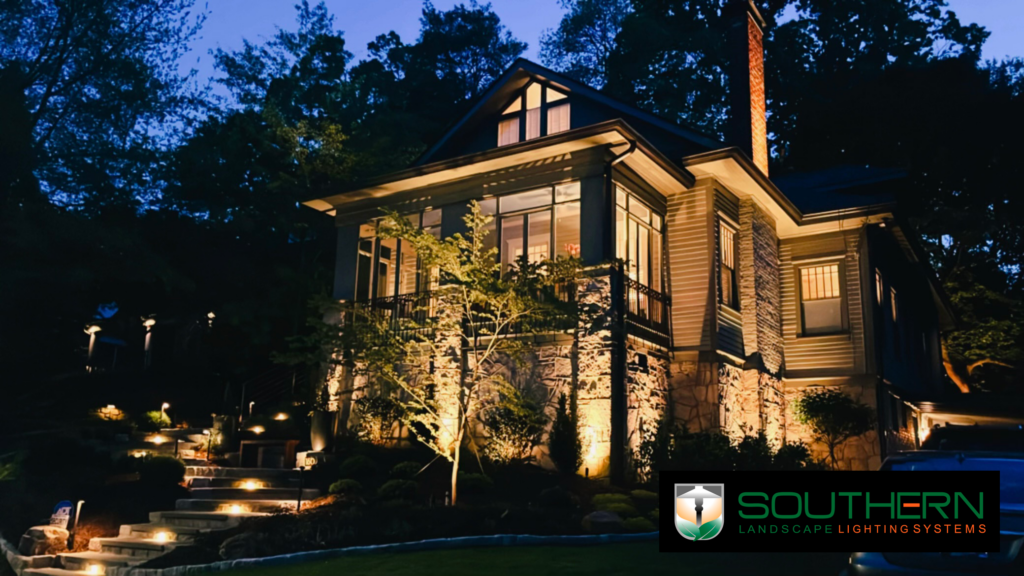Last month, we wrote about our Best Practices for Designing Landscape Lighting Systems. As important as a great design is, the next part is equally as important: the installation. Today, we’re sharing some more best practices for installing landscape lighting, featuring Lindsey Rodericks with Southern Landscape Lighting Systems and Shaun Omar with Landscape Lighting Experts, Inc.
Lindsey Rodericks is the co-founder of Southern Landscape Lighting Systems which has offices throughout Georgia. She and her husband have worked in the landscape lighting industry for 15 years, and she’s happy to share her top three best practices for installing lightscapes:

Develop Consistency
“Have a consistent order of things,” Lindsey says. “I like getting all the lights planted first. Then you eliminate trash. Then you lay out the wire runs.” Each company will have their own order, but by developing a consistent installation routine, you won’t have crew members standing around, unsure what to do next.
Play to Your Teams’ Strengths
Each member of your installation crew will have different strengths and interests. Embrace them! “You’ll have guys who like ladder work–put them on the ladder. Some like mounting transformers or digging. Give them the tasks they like or are good at,” Lindsey says. While this doesn’t mean you don’t help each individual grow in other areas, by playing to the strengths and interests of your crew, your crew will be happier and your installations will be more efficient.
Keep Healthy and Hydrated
“Installing is very physical,” Lindsey says. “You’ve got to take care of your physical self.” Lindsey encourages installers to eat healthy, stay hydrated, and take breaks in the shade to ward off heat-related illnesses. This advice is especially important for crews working out in the heat this summer.

Shaun Omar is the founder of Outdoor Lighting Experts which services Palm Beach and Broward County in Florida. He has over 30 years of experience in the landscape lighting industry. He shares his foundational tips for installing landscape lighting at a professional level:
Embrace the Fundamentals
By taking the time to get the fundamentals right, you save yourself from future problems. But what are the fundamentals of landscape lighting installations?
For Shaun, it all starts with the wire lead. “Try to go 6-8 inches,” Shaun says. Wire leads that aren’t buried deep enough are prone to nicks or cuts. Shaun adds, “In main runs, use conduits. We wire-tie all of our connections so if they get yanked, they don’t pull apart.” He also uses extra wire in case fixtures need to be moved.
Next, Shaun says to always double-check your installation with an amperage meter. “That should be landscape lighting 101: know how to use a meter,” Shaun says. Learn to use an amperage meter and avoid overloading transformers which will trip breakers and blow out fixtures.
Finally, Shaun stresses the importance of using good tools. Even a tool as simple as a wire stripper can make a difference in the efficiency and quality of the installation. “Make sure you have sharp wire strippers,” he says. “Don’t tear the wire.”
Look the Part
“Look professional when you go out. It looks good for the industry,” Shaun says. He encourages landscape lighting professionals to organize their trucks and vans and wear t-shirts with the company logo. Even the products you use can add (or detract) from your professional look. “You show [your customers] the difference,” Shaun says. “It can really make an impact. Show them the quality. All that goes along with how you present yourself.”
Be Willing to Learn from Others
With technological advances always around the corner and the consistent release of innovative tools and products, landscape lighting is an ever-changing industry. Shaun concludes by saying, “Learn from everyone.” When knowledge is shared freely among professionals, the entire industry benefits.
Next month, we’ll wrap up our series on Best Practices with tips on effective marketing for landscape lighting companies.